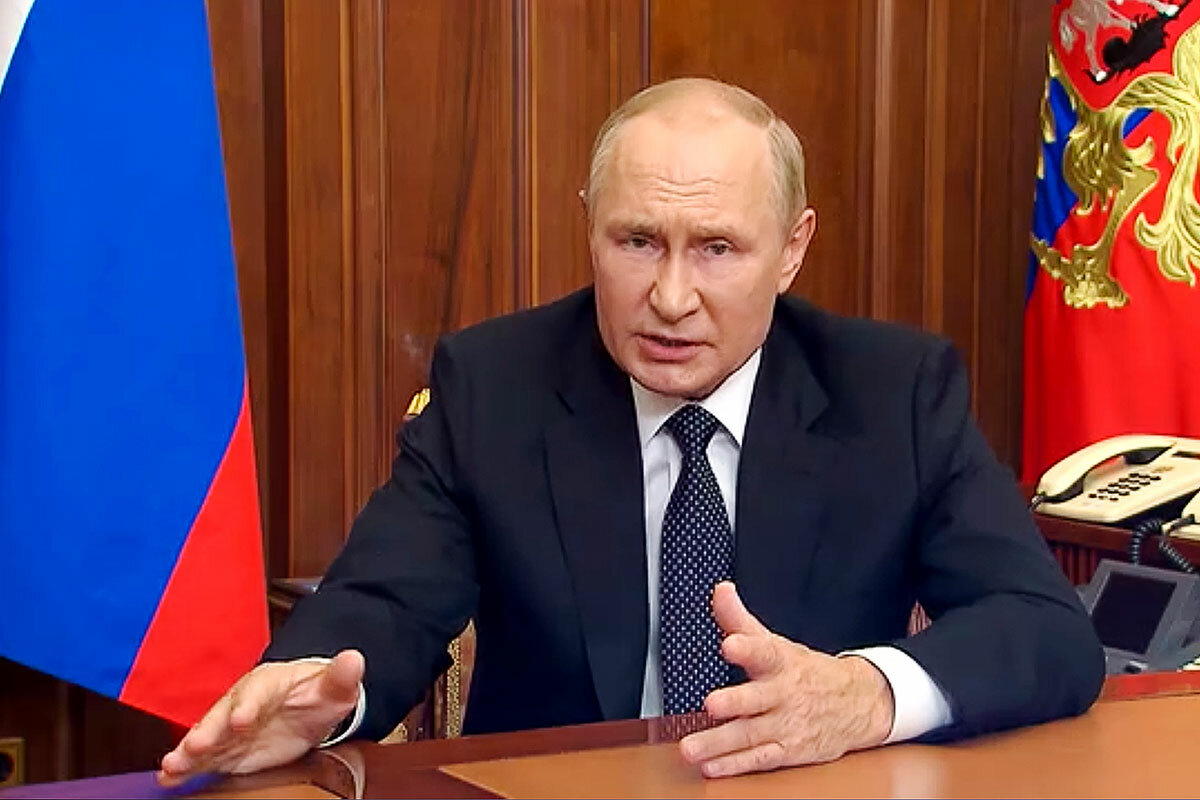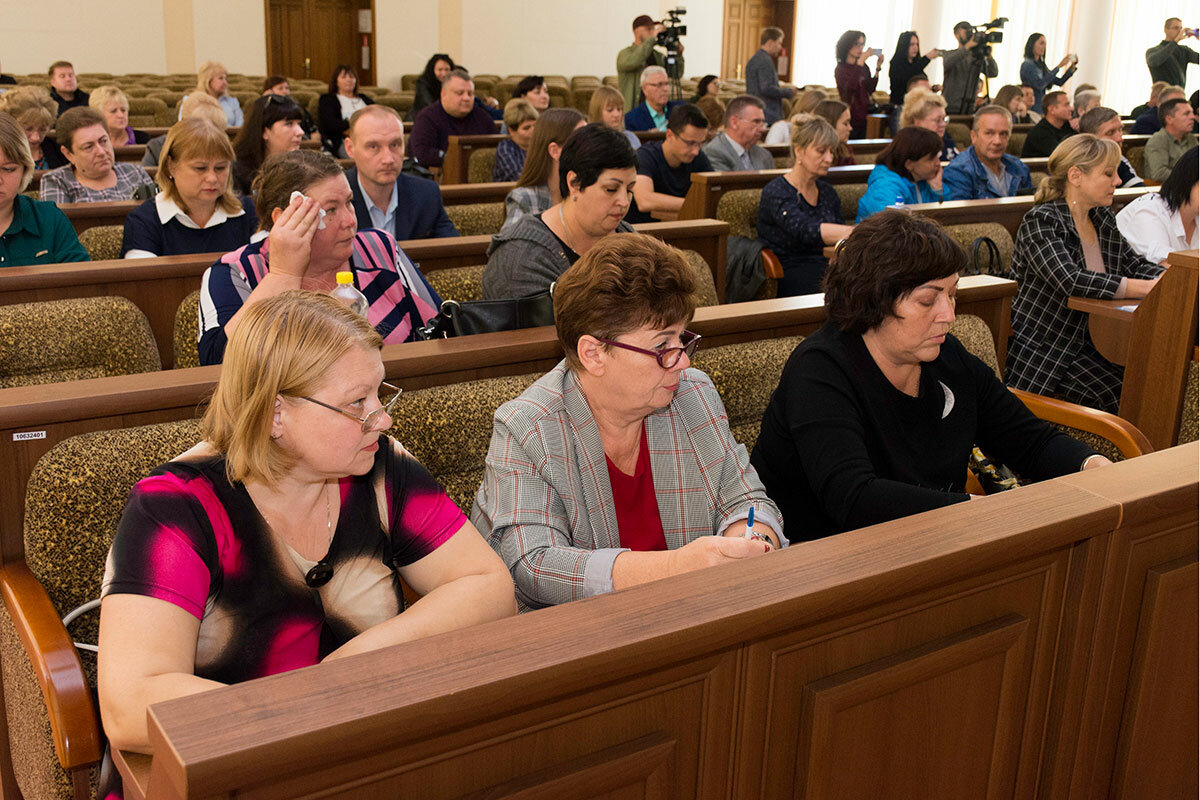More troops, more annexations: Putin announces new Ukraine plans
Loading...
| Moscow
Russian President Vladimir Putin has been hearing for months from a chorus of Russian nationalist hawks that the country’s 200,000-strong expeditionary force in Ukraine is too small to achieve victory. That complaint only grew louder after the Ukrainian army’s swift and decisive recapture of its northeastern Kharkiv region earlier this month.
In an early morning speech Wednesday, Mr. Putin largely took the hawks’ side.
He announced Russia will mobilize a much bigger army of intervention, it will sponsor the immediate Crimea-like annexation of four Ukrainian territories, and might adopt much more destructive military tactics than previously employed. The announced plan prioritizes access to resources for Russian defense industries and calls up some 300,000 Russian reservists to active duty. Mr. Putin, while certainly no dove, had up to this point tried to minimize the war’s effects on the Russian public.
Why We Wrote This
After Russia’s defeat in Kharkiv, the pressure was on Vladimir Putin to respond. Today he did, by announcing the escalation of the war in Ukraine through the mobilization of 300,000 Russian troops.
The mobilization bolsters the Russian forces already in Ukraine, made up of volunteers, contract soldiers, and separatist militias, which hawks argue are facing an ever-growing Ukrainian army that enjoys a near-unlimited pipeline of Western arms and support.
The “partial mobilization” coincides with laws hastily passed by the Duma, Russia’s lower house of parliament, that would enable a legal state of war in Russia. Formerly postponed plans to hold referendums in the Ukrainian Luhansk, Donetsk, Kherson, and Zaporizhzhia regions on requesting incorporation into Russia are now slated to take place this weekend. These measure are expected to pass, after which Moscow will regard the military front line in those regions as Russia’s own state borders.
The prospect that Russia will in the future regard those sovereign Ukrainian lands as its own territory casts an ominous light on Mr. Putin’s statement, amid a discussion of Western “nuclear blackmail” against Russia, that “in the event of a threat to the territorial integrity of our country and to defend Russia and our people, we will certainly make use of all weapon systems available to us. This is not a bluff.”
Many Western observers are interpreting Mr. Putin’s words as a threat to use nuclear weapons in case of an attempt to seize what he considers Russian land. That would be a marked shift from Russia’s existing nuclear security doctrine, which Pavel Zolotaryov, deputy director of the official Institute for US and Canadian Studies, says envisages use of nuclear weapons in only two cases: “First, if there is a threat to the existence of the Russian state. Second, when a nuclear attack on the Russian Federation has taken place.”
Sergei Markov, a former Putin adviser, argues that Russia will not launch a nuclear strike, whatever Mr. Putin’s speech may suggest. “We’re not going to use nuclear weapons in Ukraine, not under any circumstances. Why would we need to? And think of the world reaction. Especially those countries that are friendly with Russia, they would immediately be outraged and join the U.S. campaign against us. We obviously will think about that.”
“The picture is going to change dramatically”
Analysts agree that the new decisions will drastically step up Russia’s prosecution of the war in Ukraine, making it far more bloody and destructive. At the very least it will prevent any repeat of Ukraine’s Kharkiv success, say Russian military experts, who attribute the rout to long, relatively undefended front lines.
“The Kharkiv retreat demonstrated what had been obvious for some time, that Russia lacks enough manpower to hold the front line,” says Alexander Khramchikhin, deputy director of the independent Institute of Political and Military Analysis in Moscow. “The idea now is to mobilize veterans with needed skills, though it’s not really clear how many can actually be brought in.”
Some analysts say a big infusion of fresh troops will enable Russia to wrap up its offensive in the Donbas, which has dragged on for months with only incremental gains. Others say a winter offensive in the south, to take the Black Sea port of Odesa and link up with Russian-occupied Transnistria, might be possible. Regardless, it is unlikely any of the new troops will see deployment to Ukraine before January, due to both the time needed to train and Ukraine’s late-year mud season.
“The main result of these new decisions will be a major increase in Russian army manpower,” says Mr. Markov, who has been advocating a more assertive war effort for quite a while. “The main reason the Russian army has had some failures is because even though Ukraine has a quarter of Russia’s population, it’s implemented full mobilization and achieved an army that’s much larger than ours. We should be able to field [several hundred thousand] new troops soon, and that will be enough to crush the Ukrainian army.”
The troops to be called up are a selected list of about 300,000 reservists, mostly those with special military skills, and not the millions of army veterans who would become available in the event of full mobilization. Mr. Markov also references a new “volunteer” force – the Third Army Corps – that is reportedly being assembled, as well as the possibility of foreign recruits (primarily men from former Soviet, Central Asian republics) who would agree to fight in exchange for Russian citizenship.
“The picture is going to change dramatically in the coming period. Western countries will have to decide what to do. If they maintain the current level of support, Ukraine will lose,” says Mr. Markov. “There is a chance that they will escalate in some way, and we need to be ready for that. Or, perhaps, they will opt for negotiations.”
“Putin is violating the social contract”
Mr. Putin’s decision to order “partial mobilization” avoids any strenuous test of public war support, at least for the moment, say experts.
“The general attitude of Russians toward partial mobilization is going to be moderately negative,” says Denis Volkov, director of the Levada Center, Russia’s only independent polling agency. “Over the past six months people got used to the situation, life returned to some kind of normal. But now people with children of conscription age are going to feel worried. ... If the mobilization remains partial, however, that will allow a lot of people to just close their eyes and think it doesn’t concern them.”
Abbas Gallyamov, a former Putin speechwriter-turned-critic, sees the longer-term political consequences for the Kremlin in a more pessimistic light.
“Putin is violating the social contract which he had with the society at some point: You don’t go into politics and I guarantee you a comfortable life,” he said on his YouTube channel. “If one side violates the contract, the other side considers that the contract ceased to exist. That’s why it took so much time for Putin to make this decision. He knew it was going to be unpopular.”
Though relatively muted, antiwar voices are present, and responding to the evident failure of Russian war aims so far. An online petition calling for an end to the war has garnered well over a million signatures in recent days.
Depending on how things shape up on the battlefield in coming months, more drastic measures may well be in Russia’s future.
“Our turbo-patriots expected a different set of decisions from Putin,” says Yevgeny Gontmakher, a professor at Moscow’s Higher School of Economics. “They wanted a declaration of war, general mobilization, and measures that would turn Russia into a besieged fortress. They won’t stop pressuring for that.”








